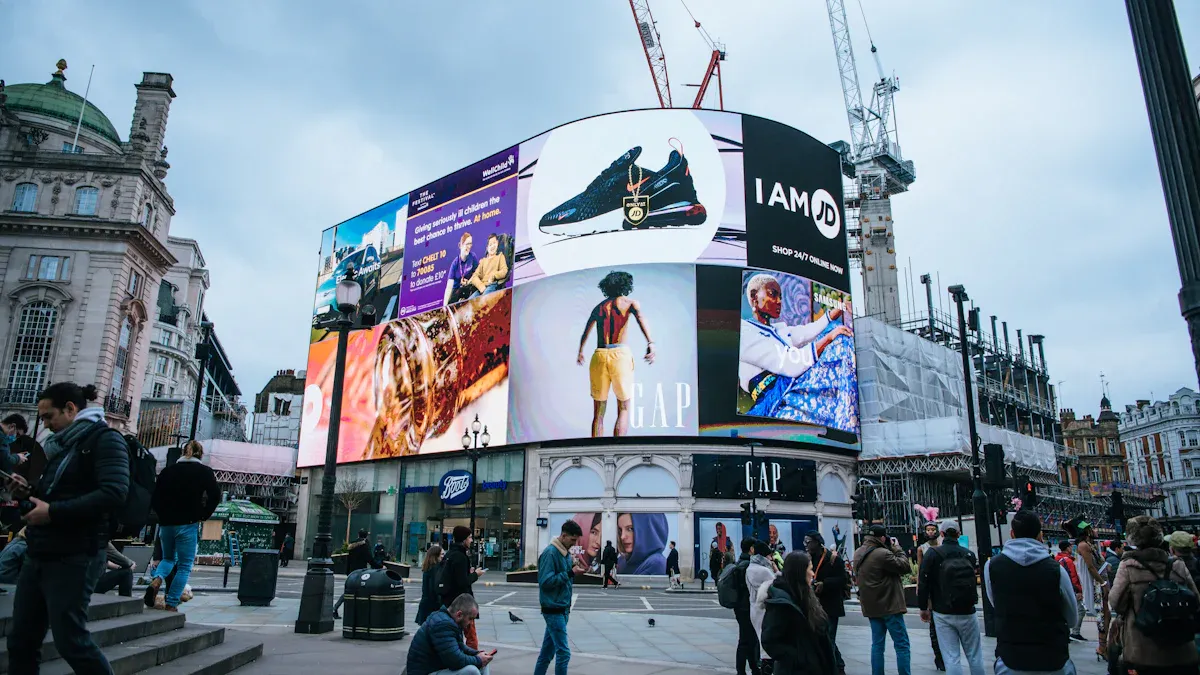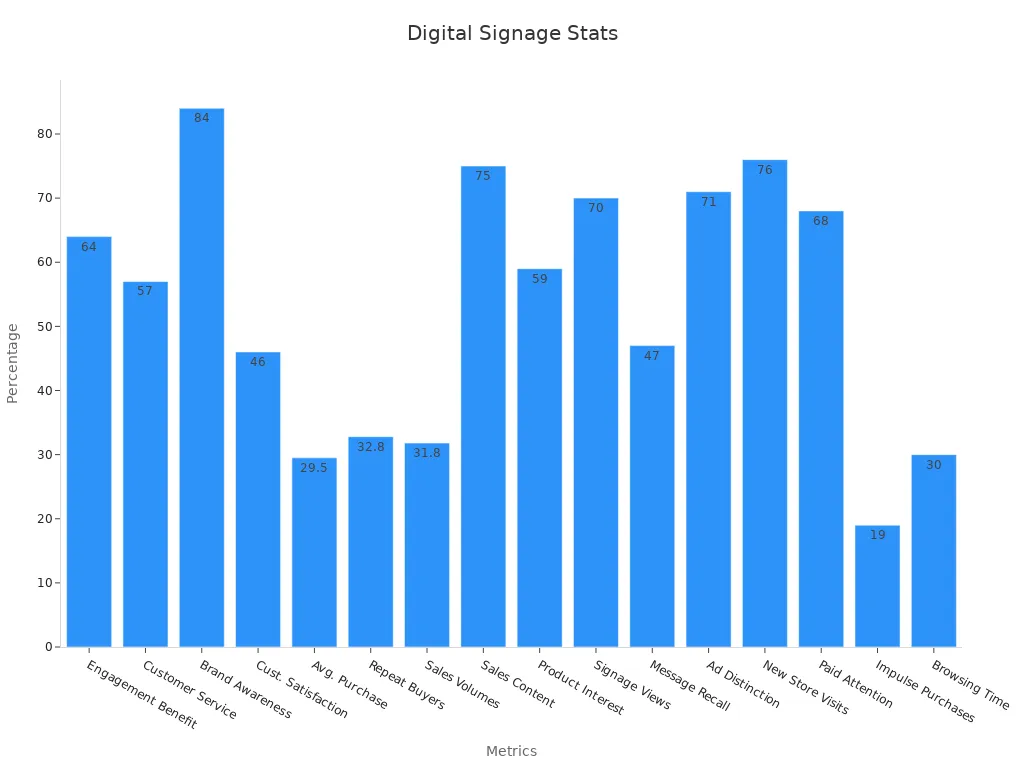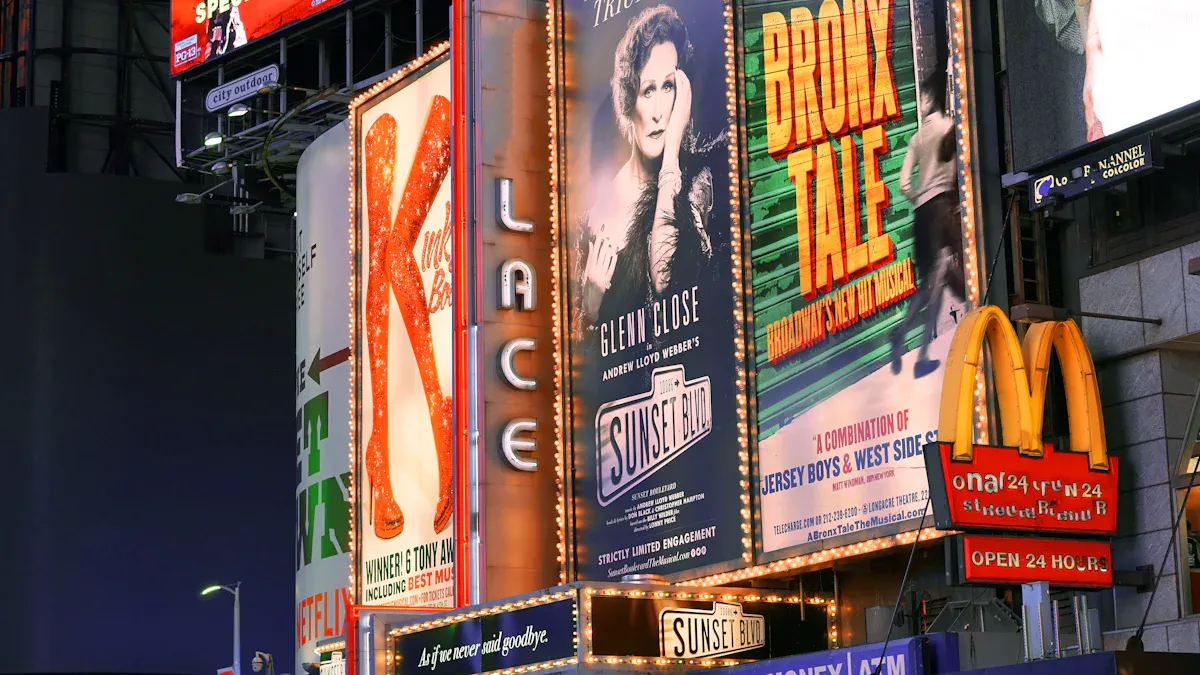Digital Signage Advertising Made Easy for Everyone

If you want an easy way to help your business or message get noticed, digital signage advertising is a strong tool. You do not need special tech skills to make a good digital signage campaign. Many businesses see results fast. For example, 76% of shoppers go into stores because of digital signs, and stores say they can get up to 33% more sales. You can use digital screens to share news, get people interested, and make the customer experience better. People remember things they see, and digital displays help your ads stand out and let people interact with them.

When you use good digital signage, you make the experience better for everyone who sees your message.
Key Takeaways
Digital signage uses screens to show bright ads that move. These ads grab attention and help sales go up fast.
You can change digital signs right away from any place. This saves time and money compared to old printed signs.
Interactive features and special content make customers more interested. This also makes their experience better.
Put screens in busy places where people can see them easily. Change the content often to help more people see your message.
Use analytics to track results and make your ads better. This helps you get more value from your investment.
What Is Digital Signage Advertising?

Simple Definition
You see digital signage advertising almost everywhere. It is in stores, restaurants, and healthcare centers. It uses screens and software to show ads or information. These screens are not like old signs. You can change what they show very fast. You can also show different things at different times. There are many kinds of screens. Some are LED walls, some are touchscreens, and some are projectors. These screens use bright pictures and moving images. Some even let people touch and interact with them.
Tip: Digital signage is not only for big companies. Small businesses, restaurants, and clinics can use it too. They can share news, menus, or health tips.
Here is a quick look at how the digital signage market is growing and changing:
Aspect | Key Insights |
|---|---|
Market Growth | Big screens are getting more popular. In 2023, 65-inch screens sold 20% more. |
Application Sectors | Retail is the top user in 2024. Healthcare is using more interactive kiosks. |
Technology Impact | Programmatic advertising and AI help make ads more focused and useful. |
LG, Samsung, BrightSign, and Omnivex are important in this industry. |
Core Purpose
The main goal of digital signage advertising is to send the right message to the right people at the right time. You can use a digital signage strategy to help sell more, share news, or guide customers. In marketing, this helps you stand out with bright screens and quick updates.
Digital signage strategy lets you:
Show moving content that gets attention.
Make messages special for each group.
Check results and make your plan better.
You can use digital signage in many ways. In restaurants, you can show menus or daily specials. In healthcare, you can show health tips or wait times. This works well because people remember what they see on screens. In fact, 68% of customers say digital signage changes what they buy. Businesses have seen sales go up by almost 30%.
A good digital signage strategy also links your in-store ads with your online marketing. You can use data to see what works best and change your plan for better results. No matter if you run a restaurant, clinic, or store, digital signage advertising makes your marketing stronger and your message clearer.
Benefits of Digital Signage Advertising
Increased Engagement
You want people to notice your message. Digital signage advertising helps you do this. It gets more attention than old signs. Studies say digital signage gets 400% more views than still signs. Moving pictures and bright colors make screens stand out. For example, 71% of customers think digital signage is easier to see than regular signs. Also, 68% of shoppers are more likely to buy things they see on digital screens. About 19% of people buy things on impulse after seeing digital displays. You can get people more interested by showing moving content. This helps them remember your message. In stores, digital signage helps you reach more people. It also makes your business easier to notice. Healthcare centers use digital screens to share news. This helps patients and visitors pay more attention.
Tip: Try using interactive features. Let people touch the screen or answer questions. This makes your message stick in their minds.
Real-Time Updates
You can change your message right away with digital signage. Real-time updates let you react to new trends or news fast. You do not need to print or replace signs. You just update your screen from your computer or phone. About 63% of people say digital signage is more eye-catching than still signs. When you update screens in real time, your info stays fresh. During COVID-19, businesses used digital signage to share safety rules and new hours quickly. In stores, you can remove sold-out items or show flash sales in seconds. Restaurants can change menus or specials fast. Healthcare workers can share health tips or wait times right away.
Note: Real-time updates help you stay ahead and keep people informed.
Cost Savings
You may think digital signage costs more, but it saves money over time. Old signs cost less at first, but you pay more for updates. Digital signage costs more at the start, but you save on printing and labor.
Cost Aspect | Traditional Signage (£) | Digital Signage (£) |
|---|---|---|
Initial Investment | 200 - 1,000 | 1,000 - 5,000+ |
First Year Total Cost | 4,400 (800 initial + 3,600 updates) | 3,500 (3,000 initial + 500 operating) |
A store saved £900 in one year by switching to digital signage. If you need to update your message a lot, digital signage is a better deal. You also save time because you can control all screens from one place.
Versatility
Digital signage works in many places and for many things. You can use it in stores, clinics, restaurants, schools, and offices. You can show ads, menus, news, directions, or safety tips. You can use video walls, kiosks, or touchscreens. This means you can talk to different groups with the right message. In healthcare, you can show health tips or reminders. In stores, you can show product videos or deals. You can even use digital signage for training or company news.
Show different messages at different times.
Aim your content at certain groups or places.
Use your screens with online marketing for a stronger brand.
Measurable Results
You want to know if your ads work. Digital signage gives you clear numbers to check your success. You can see how many people look at your screens, how long they watch, and what they do next. This helps you make your ads better.
Here are some ways to measure digital signage:
Number of views: Count how many people see your screens.
Engagement rate: See how many people interact with your content.
Conversion rate: Find out how many people buy or sign up.
Customer feedback: Use surveys to learn what people think.
A/B testing: Try different messages to see which works best.
POS integration: Connect screens to sales to see the effect on money made.
Industry | Measurable Results | Metrics Used | Example Details |
|---|---|---|---|
Retail Stores | 25% more product engagement; 12% higher sales | Engagement rate, sales figures | Sports clothing chain used digital signage in 200+ stores and saw more sales and engagement. |
Quick-Service Restaurants (QSR) | 15% higher order value; 20% faster drive-thru | Average order value, operational speed | National QSR chain used digital menu boards in 300+ places, making orders faster and more accurate. |
Corporate Offices | Better employee communication and brand visibility | Employee feedback, internal communication metrics | Global company used digital signage for safety reminders and updates. |
You can set your own goals, like brand awareness, customer interest, or sales. By tracking these numbers, you see the real benefits of digital signage advertising. Many businesses say they get a strong return on investment (ROI) and reach their goals faster with digital signage. You can use this info to make your ads even better.
Remember: Good digital signage helps you reach your goals faster and with less work.
Enhancing Customer Experience

Personalized Content
You can make each visit feel special with personalized content. Use data like time, weather, or what customers like. This helps you show messages that matter to them. Most people want this kind of experience. In fact, 91% of shoppers like getting offers made just for them. Showing the right content can boost sales by up to 30%. People get upset when content does not fit their needs. Personalization can help your business grow by 10–15%. It also makes customers 35% happier. AI-powered digital signage can study what customers do and suggest products. This keeps your content new and useful. It also makes shopping more fun for everyone.
Personalized offers and quick updates can cut wait times by 25%.
Smart mirrors let you try on clothes on a screen and get ideas.
Targeted content makes shopping easier and more interesting.
Interactive Features
Adding interactive content makes people want to join in. Touchscreens, gesture controls, and QR codes help customers connect with your brand. Interactive digital signage gets 47% more engagement than still screens. Big brands use these features to help customers. For example, McDonald's uses self-service kiosks and upsell tips. This gives faster service and happier customers. Adidas uses AR mirrors and social media links. This brings in more people and better engagement. Sephora has AR try-on mirrors and gives personal tips. This builds loyalty and makes shopping simple. Tesla uses touchscreens and VR test drives. This teaches customers and helps them learn more.
Brand | Interactive Features | Impact on Customer Experience and Sales |
|---|---|---|
McDonald's | Self-service kiosks, upsell suggestions | Faster service, higher satisfaction, increased sales |
Adidas | AR mirrors, social media integration | More foot traffic, better engagement, real-time marketing |
Sephora | Personalized recommendations, AR try-on mirrors | Stronger loyalty, easier shopping, more cross-channel sales |
Tesla | Touchscreens, VR test drives, live data displays | Educational experience, higher conversions, valuable insights |
Interactive content keeps people interested and makes them stay longer.
Consistent Branding
Using the same branding on all your digital signage helps people remember you. Digital signage can help people remember your brand 83% more than old signs. When you use the same colors, logos, and style, you build trust. Businesses with strong branding can see sales go up by 23%. Real-time updates and good content make your brand stronger. Analytics tools help you see what works best. When people see your brand often, they feel closer to it. They are more likely to come back. This makes the customer experience better and gets more people involved.
Advertising Strategies
Content Tips
You want your digital signage strategy to be noticed. Start with a strong digital signage content plan. Use a content calendar to keep things new and on time. Change up your promotions and seasonal ads to keep people interested. Add real-time data like weather or news to make your content current. Show live social media feeds or run polls to get people involved. User-generated content helps build trust and a sense of community. Use video and motion graphics because they catch the eye better than still pictures. Try A/B testing to find out what content works best. Track how people react with analytics to make your digital signage marketing strategy better.
Use a content calendar to update often
Change up promotions and seasonal ads
Add real-time data for fresh content
Show live social media and polls for more interaction
Use video and motion graphics to grab attention
Test and track content with analytics
Audience Targeting
A good digital signage strategy reaches the right people. Use location data and loyalty info to change ads as customers move. Personalized promotions based on what people do make your ads matter more. Real-time analytics help you see who is watching your screens. You can change your ads for age, gender, or interests. Interactive features like QR codes and social media links get people more involved. In stores, personalized tips help sell more. At events, AR and geofencing help you reach the right crowd. These digital signage advertising strategies help you reach more people and get better results.
Scheduling
Smart scheduling is important for any digital signage content plan. Update your content often so people do not get bored. Use short messages for quick spots and longer videos for bigger ads. Make playlists to switch up your content and keep it fun. Keep a content library sorted by topic or season for easy planning. Match your content with your marketing goals. Use analytics to find the best times and change your schedule. Real-time data feeds add urgency and make your content matter more. Automated scheduling tools make it easy to run your campaigns.
Tip: Change up your content and update often to keep your audience interested.
Placement
Where you put your screens is important for your digital signage strategy. Put digital signage in busy places like entrances, waiting areas, and checkout lines. Place screens at eye level so people can see them easily. Pick spots that help the customer but do not get in the way. Make your content fit each spot. For example, show greetings at the entrance and deals at checkout. Make sure screens are safe and easy to see all day.
Put screens in busy places for more views.
Set displays at eye level for comfort.
Avoid glare by checking the lights.
Secure screens for safety and long use.
Integration
Connect your digital signage strategy with other marketing channels for better results. Use foot traffic data and digital analytics to make your content fit. Add sensors and interactive features to link digital signage with what customers do. Track who is watching and how long to make your campaigns better. Use A/B testing to improve your marketing strategy. Measure engagement with time spent, interactions, and social media shares. Real-time tracking helps you make your content and marketing campaigns even better for the best return on investment.
Getting Started
Hardware and Software
You need the right tools to set up digital signage. Start with these main parts:
Display Screens: Pick screens that fit your space. You can use tablets, monitors, or big displays. Some screens work better inside, others outside. High-resolution screens, like 4K or 8K, make things look sharp.
Media Players: These send videos and pictures to your screens. Commercial media players work well for long hours. They play high-quality video and store content on the device. You can control screens from anywhere.
Content Management Software (CMS): This software helps you make and send content to your screens. Good CMS lets you control many screens at once. You can update content from far away and see how your screens are doing.
Connectivity: You need a good internet or network connection. Wired or wireless both work. A strong connection helps you update content fast.
Tip: Try interactive features like touchscreens or using phones. These make your digital signage more fun without costing much.
Setup Steps
You can set up digital signage by following these easy steps:
Plan Your Goals: Decide what you want to do. Do you want to sell more, share news, or help visitors?
Pick the Right Hardware: Choose screens and media players that fit your needs and budget. Make sure your hardware can show your content.
Install and Connect: Put your screens where people will see them. Connect your screens and media players to power and the internet.
Install CMS Software: Pick a CMS that works for you. Cloud-based CMS lets you manage content from anywhere and grow as needed.
Test Everything: Make sure your screens show content clearly. Check for good images, smooth video, and sound. Test your system before you start.
Note: Commercial media players and pro screens last longer. They give you better results for your digital signage.
Content Management
Managing content is very important for digital signage. Use a strong CMS to keep your content new and interesting. Cloud CMS lets you update content from anywhere. You can plan content for sales, holidays, or weather. Automation tools help you add live news or social media to your screens.
Use geo-targeting to show different content in each place.
Personalize content with AI for customer interests and times.
Connect screens to phones for real-time deals and fun features.
Tip: Real-time updates keep your screens fresh. You can change messages fast to match trends or needs.
Advanced content management can use touchless features like QR codes or gestures. These make your digital signage safer and easier to use. You can use analytics to find the best times and content for your viewers. This helps you get the most from your digital signage.
Performance Monitoring
You need to check how well your digital signage works. Use your CMS to track important numbers and make your ads better. Here are some ways to measure how you are doing:
KPI Category | Metrics / Data Used | Application / Example |
|---|---|---|
Revenue-Oriented Measurement | Sales of products; Average sales during ad periods | See if digital signage helps you sell more by watching sales. |
Customer-Focused Monitoring | Foot traffic; Loyalty sign-ups; Social media engagement | Check if more people visit, join, or interact with your brand. |
A/B Testing Analysis | Messages; Designs; Sign placement; Timing of ads | Try different content to see what works best. |
Internal-Facing Metrics | Employee recognition; Company events; Upsell rates | Use screens to boost morale and track upsell success. |
You can use these numbers to see what content works best. Try A/B testing by showing different messages or designs. Watch which screens get the most looks. Change your content and screen spots for better results. Checking your setup often helps you get the most from your digital signage.
Remember: Testing and making changes helps your digital signage work better. Keep making your content and plans better for the best results.
Common Mistakes
Content Overload
You might think more information helps people. But too much on your digital signage can hurt. Studies show people feel stressed when they see too many messages. This makes it hard for them to pay attention. They may stop trusting your messages or ignore your screens. Too much information can make people tired and worried. This means they do not want to look at your screens. To keep your digital signage working well, use clear and simple messages. Only show a few things on each screen. Give people time to read and understand what they see.
Tip: Less is better. Use short messages and strong pictures to share your idea.
Ignoring Analytics
You need to check how your digital signage is doing. If you do not look at analytics, you waste money and miss ways to get better. Here are some problems if you skip checking your data:
Wasted clicks from fake or bot traffic cost you money because you pay for clicks that do not help.
Too many fake views make your results look better than they really are.
Bad data makes you choose the wrong things and hurts your campaigns.
High click rates but low sales can mean fake traffic.
Strange places or times for traffic can show fake users.
Short visits mean bots, not real people, are looking.
Big jumps in traffic at odd times can mean fake clicks.
If your ad reports and analytics do not match, fraud may be the reason.
Always check your analytics. This helps you find problems, save money, and make your ads better.
Poor Placement
Where you put your digital signage is very important. If you put screens in bad spots, not many people will see them. Bad placement means fewer people walk by and less interest. For example, if a screen is too high or too low, people may not see it or feel awkward. Screens work best at eye level or just above. This helps everyone, even people in wheelchairs, see your content. Good placement makes your screens easy to see and helps your message reach more people.
Outdated Content
You must keep your content new. Old messages make your business look like you do not care. People stop looking if they see the same thing every day. Change your screens with new deals, news, or tips. Use a calendar to plan updates often. When you keep your content fresh, people know you care about their experience. This builds trust and makes people want to look at your screens again.
Note: Set reminders to check and update your digital signage content often.
Digital signage advertising helps you reach more people. It is an easy way to help your business grow. You can set it up quickly and see results fast. There are many clear benefits to using digital signage.
Benefit | Result |
|---|---|
Higher ROI | 34% increase |
More Engagement | 400% more than static signs |
Bigger Sales Volume | 31.8% increase |
Lower Costs | 48% less than print |
McDonald’s saw 15% more add-ons with digital menu boards.
Healthcare centers used digital screens to cut wait times by 35%.
Try digital signage now. It is simple and can help your business make a big difference.
FAQ
What is digital signage advertising?
Digital signage advertising uses screens to show ads, news, or information. You control what appears on the screens. You can update messages quickly. This helps you reach more people and keep your content fresh.
Do I need special skills to use digital signage?
You do not need advanced tech skills. Most digital signage systems use simple software. You can drag and drop content or use templates. Many companies offer support and training.
How much does digital signage cost?
Costs vary. You pay for screens, media players, and software. Some plans start at $20 per month. You save money over time because you do not print new signs. Digital signage often gives a higher return on investment.
Can I update my content from anywhere?
Yes! Most digital signage software lets you update screens from any computer or phone. You log in, choose your content, and send it to your screens. This makes it easy to keep messages current.
What types of content can I show?
You can display many types of content:
Videos and images
Slideshows
Social media feeds
News and weather updates
Tip: Mix different content types to keep your screens interesting.
See Also
How To Implement Digital Signage For Optimal Returns
Using Digital Signage To Effectively Share Information
Exploring Digital Signage Solutions Across Singapore Markets
Understanding Digital Signage Technology Benefits And Deployment

